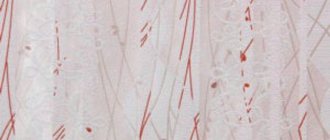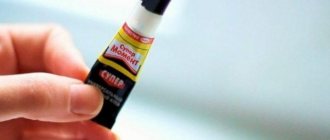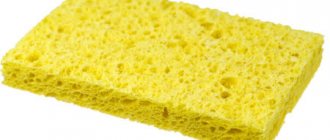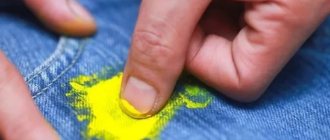There are many ways to get paint on your clothes. Most often children encounter stains. While walking on children's playgrounds, you may come across painted benches or swings. The highest chance of getting stained with paint is during renovation or painting. But you shouldn’t give up on contaminated things. In most cases, everything can be fixed, you just need to know how to remove paint from clothes.
General recommendations
Before removing paint from clothing, you need to know its type. Further cleaning will depend on this. In addition to the dye itself, the type of fabric and age of the stain will also affect the method.
A few tips for removing paint:
- The fresher the stain, the easier it is to deal with.
- Before treating the stain with your chosen product, place a few napkins under the stain to be on the safe side.
- To make sure the product is safe, test its effect on an inconspicuous area of fabric.
- To localize stains, scrub the stain from the edges to the center.
- Stain remover works well when washing, but before doing so, use the methods below.
- When finished, rinse the item and dry it in fresh air.
We will try to remove paint from clothes:
- stamp,
- acrylic,
- latex,
- water-based,
- oil,
- watercolor,
- gouache,
- tempera,
- printer ink,
- hair dye,
Features of removing paint from pants
To successfully remove paint stains from jeans, you must follow certain rules and know some features of the procedure:
- It is always easier to wipe off fresh paint than dried paint, which has already been absorbed into the fibers of the fabric, so you should get to work as soon as possible;
- To prevent the dye from being absorbed, apply a paper napkin to the fresh stain and remove the stain without rubbing or smearing it;
- the denser and coarser the material, the easier it is to wipe off the dirt, and dyes on thin, delicate fabrics are difficult to remove, especially old ones;
- When processing, you need to move from the edges of the stain to its center so that it does not acquire an even larger size;
- when using aggressive agents - gasoline or solvent, it is worth first testing their effect on a similar material;
- If the contamination is too large, then it is better to contact a dry cleaner without wasting time; using folk methods you can successfully wipe off only small splashes and smudges.
We recommend reading: How to remove brilliant paint from linoleum
To remove old, dried paint from jeans, you will have to work hard. In addition to water and soap, you will need more effective agents that can penetrate the fibrous structure of the fabric. If aggressive substances are used for work - acetone, solvent, gasoline, then you should take care of personal safety measures. The treatment must be carried out wearing rubber gloves, in a well-ventilated, ventilated area, which will prevent irritation of the respiratory tract.
Important! The easiest way to wipe off is acrylic, water-based or watercolor paint. Oil-based paints and varnishes are difficult to remove or cannot be removed at all.
How to remove coloring compounds
First, let's find out how to remove paint from clothes and what needs to be done to do this. First of all, turn the item inside out and place a paper towel under the front side. Regarding what you can use to wash stains, we use the following products:
- Laundry soap. A partially forgotten legacy of the Soviet Union. For complex stains, apply toothpaste before using soap. Only after this is it treated with soap and cleaned with a brush.
- The solvent may not be used on all types of fabrics. But at the same time, it is an effective remedy that allows you to get rid of most stains. You can use purified gasoline or white spirit.
- Nail polish remover is powerful enough to remove most dyes.
- A solution of ammonia and gasoline will help remove paint stains at home.
- Vegetable oil is used to remove fresh stains; after finishing, the item is washed to remove any remaining oil.
There are many more means to remove paint from fabric, but these are the ones used most often.
Remember 4 rules
How to remove paint stains from clothes? You need to know four basic rules that will help you cope with the task.
- The fight cannot be delayed. Got paint on your pants? Don't put them away, hoping that someday you'll get around to cleaning them. The sooner you notice traces of paint, the higher the likelihood that the item will be saved. Always inspect clothes after a walk in the park, check your baby’s things after drawing.
- Determining the type of paint is half the battle. It is important to know what kind of paint the clothes were stained with. This will help you choose a product that will effectively and quickly remove the “blot”.
- We save, but do not spoil. Before using traditional methods, you need to check the composition of the fabric. There are not many universal solvents at hand. The product must be selected taking into account the characteristics of the material. This is the only way to clean the item without ruining the fabric.
- A test drive is required. Any solvent must be tested first. It is applied to the seam from the wrong side. This simple method allows you to find out how a material reacts to a particular substance. This reduces the risk of hopelessly damaging the item.
The smaller the area of contamination, the higher the chances of returning the item to the wardrobe. Huge stains (especially if they are already old) are almost impossible to remove at home. If you see a large paint stain, take your clothes to the dry cleaner. That's where you want to go with designer items. Experiments on expensive clothes are unacceptable - the risks of completely ruining the outfit are too high.
How to remove dried paint from clothes
The hardest thing to remove from clothes is dried paint. It is better not to let this happen, but sometimes you may not see the contamination in time. In such cases, the most serious and aggressive means are used. First, remove dried paint mechanically using a non-sharp object. Try not to damage the fabric while doing this. Buy purified gasoline and use a cotton pad to treat the stain. The procedure should dissolve the bulk of the dye. In the process, replace the contaminated cotton wool with new one. At the end, create a soda solution and treat the surface with a sponge. To remove residues and the smell of gasoline, wash the item.
Removing old stains
Preparing the Rag
It is not always possible to detect a problem right away. And then methods for removing old stains come to the rescue. Turpentine softens old paint well, so you should try it first.
Dishwashing detergent is effective in the fight against dried stains. In its composition you can find substances - fat thinners, which can dissolve traces of paint. The first step is to soak the desired item in a mixture of water and detergent for at least 11 hours. Then the mark will need to be rubbed with the hard side of the sponge.
Expert opinion
Irina. Housewife.
Ask a Question
In order not to throw away an item with a paint stain, you can take it to the studio and sew on an interesting applique to match the clothes.
How to Remove Oil Paint
Removing oil paint from clothes is quite difficult. Mechanical cleaning will not help here. This type of dye is amenable to solvents. You can use acetone or a liquid containing it for decorative varnish. The method is not suitable for colored items. It is enough to treat the contaminated surface, remove the residue after 10 minutes and wash.
How else can you remove oil paint from clothes? Take purified gasoline and lightly treat the stain. There shouldn't be a lot of funds. After a few minutes, rinse and put the item in the washing machine.
You can remove oil paint from clothes using turpentine. The principle of use and operation is the same as with gasoline. After finishing, the item is also washed. If there are stains from the product itself, they are treated with ammonia before washing.
For delicate fabrics it is better to use more gentle methods. Use the following recipe: melt the butter at room temperature, add the same amount of washing powder and stir until a homogeneous mixture is formed. Apply the resulting paste to the stain and gently brush with a toothbrush. After removing most of the paint, apply a little more mixture and leave for two hours. Now wash by hand using laundry soap and put it in the washing machine.
Gouache
Products for removing gouache are sold in household chemical stores, hardware stores and pharmacies.
Soap
The stain is moistened with water, which washes off the main part of the dye. The stain is washed off by hand with soap. You can soap it up and wash it off after a while. Fresh gouache is washed off immediately, the dried mark is rubbed off with a brush, soaped again and washed off. If traces of paint remain after washing, additional products are used.
Glycerin and ammonia
The components are mixed in equal proportions. The mixture is applied to the stained area for half an hour. Traces of gouache are soaped with laundry or toilet soap. The item can be washed by hand or by machine.
Gasoline and vinegar
In a separate container, vinegar and purified gasoline are mixed in a 1:1 ratio. The first ingredient is heated first and then the second ingredient is added.
Cleaning is done with gloves.
The product is applied with a sponge, after a few minutes the treated area is washed off, the item is completely washed. To remove the smell of gasoline during rinsing, add fabric softener to the water.
Eucalyptus oil
The clothes are spread out on a flat surface, oil is poured onto the stain, after 10 minutes. Washable in warm water with detergent.
Toothpaste
The stained area on the clothing is moistened with water, washed, and then toothpaste is applied to it. After 5 minutes, the treated stain is rubbed with a brush or rubbed with your hands. Washing at the end is required.
Mustard powder
In a separate container, mustard powder is diluted with water to a mushy state. Mix for 15-20 minutes. applied to a dirty place.
The mustard composition should not dry out; it is constantly moistened with water.
When the gouache softens, it, along with the pulp, is removed from the clothes, and the latter is washed in a machine.
White Spirit
Do not remove gouache from delicate materials. Stains are treated with white spirit using sponges or a washcloth, then the product is washed.
Soda
First, the problem area is washed under the tap, then soda is poured onto the stain. After 15 min. the remaining soda and gouache are washed off, and the item is washed using the usual method.
Detergents
- The bulk of the gouache is removed with running water.
- Dried paint residues are removed with a brush.
- Concentrated detergent is added to a container of warm water.
- The clothes are soaked for half an hour in the prepared solution, and then washed by hand or by machine.
Butter and washing powder
One teaspoon of oil is mixed with a small amount of powder until smooth. The mixture is rubbed into the stain. After half an hour, hand or machine wash is done.
Dish detergents
It is better to use thick gels.
First, the stain is moistened, generously lubricated with gel, and after half an hour it is washed in warm soapy water.
Acetone or nail polish remover
The method cannot be used for synthetic-based fabrics and with unstable dyes. Place cellophane or rags under the stained area. The top of the stain is treated with a sponge soaked in water. When the bulk of the paint has been removed, the remains are rubbed off with acetone. After 15 min. The item is washed first by hand and then in the washing machine.
How to get rid of water-based and acrylic paint
Often there is a need to wash acrylic or water-based paint from clothes. It is used for painting benches and other objects in public places. Anyone can find it on clothes. Alcohol will help get rid of this type of paint. Stretch the fabric and rub with a cotton pad soaked in alcohol.
Sometimes washing with washing powder helps to wash off water-based paint. In this case, first with cold and then with hot water. Consider the maximum permissible temperatures for your fabric type.
There is another way to remove acrylic paint from trousers and other clothes. Use the following recipe: mix vinegar, ammonia and salt in a ratio of 2:2:1. Mix thoroughly and apply to stains; after a few minutes, scrub off with a brush. Residues are washed by hand with powder or laundry soap.
Paints for painting
Most often, children's things suffer from painting paints.
Watercolor and gouache are substances that dissolve in water. If you immediately wash away the stains left by them, they will wash off quite easily. To do this, first the product should be rinsed under running cold water until the residual color (pale) remains and/or soaked in water with powder (depending on the size and saturation of the defect). Then wash either by hand or in a washing machine with a large amount of powder, choosing the longest cycle.
Important! To prevent the paint from eating into the fibers of the product, the water temperature should not exceed 30 degrees.
Most often, children's things suffer from painting paints.
If you did not have time to remove a stain that has just appeared and you need to remove an old one, then you can use one of the proposed methods:
- use laundry soap, thoroughly rubbing the stain;
- apply a stain remover for this type of fabric;
- pour a little heated vinegar onto the stain (cannot be used on delicate items).
After using any of the proposed methods, you should leave the item for 1 hour and then wash it.
Tempera and oil paints contain oil. Dish soap (detergent) can help rid the item of their traces. We rinse the stain under cold water, pour the detergent onto the fabric and leave for half an hour (an hour), then wash it by hand. If the stain is old, you should also use a stain remover.
Clean clothes from hair dye
Due to their poor financial condition, women often resort to dyeing their hair at home. People are turning less and less to hairdressers and hairdressers. During the dyeing process, unexpected stains may arise that make you wonder how to remove hair dye from clothes. This type is especially durable because it must remain on the hair even when washed with shampoo or other detergents. You need to act as quickly as possible. You can get rid of fresh stains using regular hairspray or washing.
The most difficult thing to remove is an old stain on clothing. Try using hydrogen peroxide, but it can discolor fabrics, so it's only suitable for white items. Treat the stain and leave for half an hour. Rinse off the residue and throw the item in the wash.
Synthetics and wool are best cleaned with vinegar. If an item contains henna, it requires a special approach. You will need a solution of hydrogen peroxide, ammonia and water. Mix thoroughly, treat the stain and leave for a few minutes. All that remains is to wipe off the residue and wash it.
Traditional methods
In some cases, it is not necessary to immediately use aggressive chemicals - you can solve the problem using folk recipes.
Gasoline and alcohol
Gasoline is good for removing stains from oil paints. You need to apply it to a cotton swab and rub the stain all around. After the procedure, the item is washed using powder or gel.
Attention! It is necessary to purchase only refined gasoline, which is sold in hardware stores. A regular product may stain clothing due to impurities in the composition.
Another effective remedy is a combination of laundry soap and alcohol. This recipe can be used against difficult stains on silk and satin. First, the blot is rubbed with soap, then the fabric is rinsed, and the contaminated area is treated with alcohol. Before this, the liquid must be heated in a water bath. After cleaning, you must hand wash the item in hot water.
Alcohol and salt help remove paint from both linen and nylon fabric. The blot needs to be rubbed with heated alcohol on the reverse side, then prepared with a saline solution and washed off any remaining dirt.
Hair fixation spray
Many hair styling products contain weak solvents. They do not harm human health, but help remove stains. Just spray the varnish and throw the item in the wash.
Salt and vinegar
To clean clothes from acrylic dye, you need to prepare a solution from the following ingredients:
- salt – 1 tbsp. l.;
- ammonia - 2 tbsp. l.;
- vinegar - 2 tbsp. l.;
- water – 750 ml.
The components need to be mixed and poured into the blot, leaving the product in the basin overnight. It is recommended to cover it so that the smell of ammonia does not spread to other rooms. The procedure is repeated until the dye completely disappears.
Acetone
Instead of acetone, nail liquid is suitable. First you need to soak a cotton swab in the solution, then start rubbing the stain from the edge to the middle. At the end of the procedure, the item is thrown into the machine.
Attention! Acetone is not used on delicate fabrics.
Turpentine
This product is suitable for removing stains from delicate materials such as silk, satin and wool.
First, apply a little turpentine to a cotton swab to treat the blot on the front and back of the fabric. After 10 minutes, cover the stain with paper towels on both sides and press together with your palms. There will be traces of paint on the paper that were removed by the product.
After this, the dirt is wiped off again with turpentine and left for 60 minutes, then the clothes are washed in the usual way in a machine or by hand.
Glass cleaner
To remove stains from clothes, just spray glass cleaner and rub it in for 2-3 minutes. After this, the dirt is rinsed off and the cleaning is repeated again.
Paint stains are not a death sentence for things, since they can be removed with folk remedies and household chemicals. Before the procedure, you must wear protective gloves and follow safety precautions. If the fabric is expensive and requires special care, then it is recommended to take the clothes to the dry cleaner rather than clean them yourself.
5/5 — (1 vote)
How to remove ink from a printer
Having a printer at home, sooner or later paint contamination from it occurs. This could be during refills, home repairs, or the device simply malfunctioned and released too much ink onto the paper. In any case, action must be taken urgently. It is advisable to immediately soak in cold water, or better yet, wash in it. Ideally, hand wash in cold water using laundry soap. To remove old paint, treat with hydrogen peroxide for 10 minutes before washing.
Quick ways to remove paint from things
Chlorine
Most often, chlorine-containing products are used to remove dye from cotton and linen fabrics (their fibers are very wear-resistant) of white and light shades.
In the store you need to buy “Belizna”, “Perrox” or other chlorine-containing laundry detergent. Pour 6 liters of water and 80 milliliters of the purchased product into an aluminum bucket, put it on the stove and let it boil. Place the product there and boil for half an hour, periodically drowning the product with wooden tongs if it floats.
Remove the product and place it in the washing machine. If available, then select the “Heavily soiled laundry” mode for washing, add bleach (gel or powder). Dry the product on the balcony, out of direct sunlight.
Tar soap
Tar soap or laundry soap will also help remove paint. It is sold in any store or supermarket. The paint mark is wetted under water, and then rubbed with the available soap. Leave the grated product for about 2 hours. Rinse well and repeat the process 2-3 more times (depending on the degree of contamination and the result achieved). You can rub the stain with a hard sponge or brush (pay attention to the material of the fabric).
Place the item in the washing machine. Fill the powder compartment with 100 grams of baking soda and add stain remover (Sarma, Domestos, Vanish) to the adjacent compartment. We use intensive washing. Dry the product without direct exposure to ultraviolet radiation.
Hydrogen peroxide and lemon
In some cases, even lemon helps.
Pass the lemon through a meat grinder or grind it with a blender to obtain a porridge-like mixture. The contaminated area is moistened with peroxide, and lemon pulp is laid out on top and rubbed in. After 60 minutes, remove excess with a paper napkin or towel. If the result is not satisfactory, then repeat until the desired result is achieved.
You can replace hydrogen peroxide with Chlorhexidine, which is also sold in pharmacies. It has identical composition.
Important! If a stain needs to be removed from colored fabric, then the advice is to not use peroxide, only lemon juice.
After all steps, wash in a machine or by hand.
Vinegar essence
Vinegar essence and food vinegar are not the same thing. The essence has a concentration of 65-70%, and table vinegar - 6-9%. The fact that the essence is used in production to improve the brightness of fabric and strengthen the structure is little known. But if you know the correct proportions, then vinegar essence can be used at home for all colors and types of fabric.
To soak a stained cloth, mix 75 milliliters of essence and 3.3 liters of filtered water. Place clothes in the solution for 1-1.5 hours. Then wash in a washing machine. If the contamination is small, it should be treated locally.
Removing other stains
It is not uncommon to need to clean other types of paint. It is worth considering separately for children: gouache and watercolor. They are water-based, so fresh stains can be removed with regular washing. Large stains may not be washed off completely, leaving their mark on the entire surface of the clothing. Such contaminants are first washed by hand under waste water, after which they are also sent to the washing machine.
Enamel products are susceptible to solvents. Soak a cotton pad in it, squeeze out the excess and start wiping off the dye. As the color changes to the cotton wool, replace it with a new one.
The easiest way to deal with stains on leather products. Very fresh marks can be wiped off with regular wet wipes. More complex ones with vegetable oil or laundry soap. Rub the selected product onto the stain, wipe with a dry soft cloth and remove any residue with a damp, clean cloth.
Delicate fabrics require a unique approach. Heat ammonia to a temperature of 40-50 degrees, lightly moisten a cotton swab and wipe gently. Replace the tampon as needed and continue cleaning until completely clean. Finally, pour warm water into the basin, add enough salt to form a weak saline solution. Rinse the item in it.
If it is difficult to determine the type of paint, use a universal laundry soap. Rub the contaminated surface thoroughly and leave for 1-2 hours. Wipe with cotton and rinse.
Useful tips
When it becomes necessary to manually remove paint from clothing, first of all, you need to think about the degree of protection of the skin. We are talking about rubber gloves. This way you will protect your hands from chemicals and from dryness when washing.
Before using any drug, test its effect on an invisible area of tissue. If there are no negative consequences, you can continue cleaning.
The stain remover works great for this type of stain. If pollution is an everyday thing for you, it is advisable to buy the product and use it on an ongoing basis.











